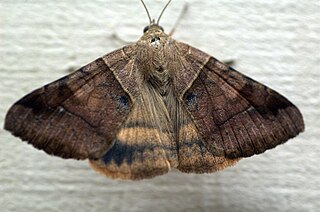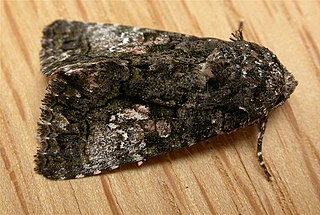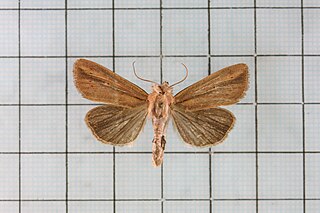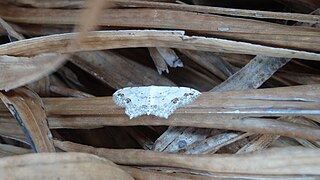
Mocis undata, the brown-striped semilooper, is a moth of the family Erebidae. The species was first described by Johan Christian Fabricius in 1775. It is found in the Afrotropical and Oriental regions, including India and Sri Lanka.

Aedia leucomelas, the eastern alchymist, sweet potato leaf worm or sorcerer, is a moth of the family Noctuidae. It is found in large parts of the world, ranging from Europe all over Asia up to Japan and some African countries. The subspecies Aedia leucomelas acronyctoides is found in Australia.

Dordura is a monotypic moth genus of the family Noctuidae erected by Frederic Moore in 1882. Its only species, Dordura aliena, was first described by Francis Walker in 1865. It is found in the Indian subregion, Sri Lanka, Myanmar, Thailand, Peninsular Malaysia, Sumatra, Borneo and New Guinea.

Hulodes caranea is a species of moth of the family Erebidae first described by Pieter Cramer in 1780. It is found from India, Sri Lanka, Myanmar, Java, Hong Kong to Queensland and New Guinea, it is also found on the Marianas and Carolines.

Mythimna decisissima is a moth of the family Noctuidae first described by Francis Walker in 1856. It is found from India across south-east Asia including Hong Kong, Japan, Taiwan and Australia in Queensland and New South Wales. It is also present in South Africa.

Thyas coronata is a species of moth of the family Noctuidae first described by Johan Christian Fabricius in 1775. It is found from the Indo-Australian tropics of southern China, Taiwan, Japan, Nepal, India, Sri Lanka to Micronesia and the Society Islands.

Ercheia cyllaria is a species of moth of the family Erebidae first described by Pieter Cramer in 1779. It is found in the Indian subregion, Sri Lanka, Taiwan, Japan, Indochina, Thailand, Peninsular Malaysia, Sumatra, Borneo, Seram and the Kai Islands.

Ctenoplusia limbirena, the Scar Bank gem, or silver U-tail, is a moth of the family Noctuidae. It is found in south-western Europe, Africa, the Canary Islands, Arabia, the southern Himalayas, India, Sri Lanka, Indochina to south-eastern China, Taiwan, Sulawesi, Bali and Timor. In New Zealand, it has been established since 2011.

Mnesiloba dentifascia is a moth of the family Geometridae first described by George Hampson in 1891. It is known from the Oriental tropics.

Mythimna pallidicosta is a moth in the family Noctuidae first described by George Hampson in 1894. It is found from north-eastern India to western China, Sri Lanka, Taiwan, Sundaland, Flores, the Philippines and Japan.

Gesonia obeditalis is a species of moth of the family Noctuidae first described by Francis Walker in 1859. It is found from eastern Africa, the Seychelles, the Maldives and the Oriental tropics of India, Sri Lanka east to the Philippines, the Sula Islands and Australia. The adult moth has brown wings with a scalloped dark brown band near the margin. The hindwings are similar in pattern to the forewings but are a paler shade of brown.

Maliattha signifera is a species of moth of the family Noctuidae first described by Francis Walker in 1858. It is found in south-east Asia, including China, India, Japan, Taiwan, Korea and Thailand as well as in Australia (Queensland).

Scopula pulchellata is a moth of the family Geometridae. It is found in the Indo-Australian tropics, from India, Sri Lanka to Taiwan and the Solomon Islands, as well as in Africa.

Eutelia geyeri is a moth of the family Noctuidae first described by Rudolf Felder and Alois Friedrich Rogenhofer in 1874. This species is found in India, Sri Lanka, China and Japan, as well as from Africa, where its presence had been reported from Lesotho and Seychelles.

Lacera alope, the toothed drab, is a moth of the family Erebidae. The species was first described by Pieter Cramer in 1780. It is found in Africa, where it is known from southern and eastern Africa, including several islands of the Indian Ocean, Saudi Arabia, and southern Asia from India, Sri Lanka to China.

Risoba repugnans is a species of moth of the family Nolidae first described by Francis Walker in 1865.
Roxita adspersella is a moth in the family Crambidae. It was described by Pieter Cornelius Tobias Snellen in 1893. It is found in Sri Lanka.
Haimbachia strigulalis is a moth in the family Crambidae. It was described by George Hampson in 1896. It is found in India, Sri Lanka and China.
Pycnarmon nebulosalis is a moth in the family Crambidae. It was described by George Hampson in 1896. It is found in Sri Lanka.

Sphingomorpha chlorea, the sundowner moth, is a species of moth in the family Erebidae that is native to Africa and southern Asia. The species was first described by Pieter Cramer in 1777. It is a fruit-piercing moth and a notorious pest in orchards. The fruit is pierced while performing a vertical and rhythmic movement of the head.
















